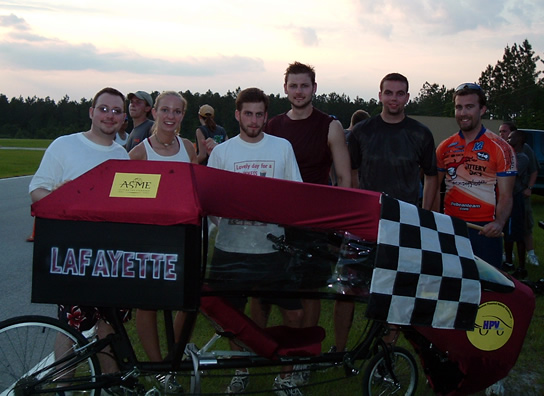

Senior Design
ME 497 & 498 - Senior Design Project I, II

The American Society of Mechanical Engineers’ (ASME) Human Powered Vehicle (HPV)
competition challenges teams to design and fabricate a vehicle, following ASME guidelines, to
safely compete in the HPV endurance and sprint races.
In this, the inaugural year of Lafayette’s participation in the HPV competition, the student team engineered unique, cost efficient solutions to the complex task of harnessing mechanical advantage to propel a human quickly and safely under her/his own power. The process has been documented, equitable, and timely. The team’s efforts focused on design, analysis, testing, and safety. Additionally, the fabrication process was student-centered; all items not purchased were manufactured by the team members under the supervision of Lafayette College technicians.
The design process was cooperative and productive. Using collaborative brainstorming sessions, literature review, and modern design software, the team was able to efficiently explore vehicle options and select appropriate engineering solutions. Autodesk Inventor 7 ® enabled the team to parametrically model design concepts at various stages. Capitalizing on the ease and versatility of the software, the HPV design team was able to rapidly consider and implement design modifications.
Simple first-order analyses helped to add focus to the initial design process. Ultimately, the team utilized the Finite Element Method to refine preliminary designs. ANSYS 7.1 ®, a full package Finite Element Analysis program, was employed to this end. Additional analysis methodologies included graphical and empirical techniques. The analyses conducted yielded significant results, which were used to make meaningful changes to the HPV design.
While empirical results and engineering analyses provide a sound basis for design, prototype
testing was crucial to the development and verification of the final product. Testing results were
used to analyze and optimize the HPV. Testing helped to simulate and prepare for actual
competition conditions and thusly, aided in confirming the team’s analyses. With this
confirmation came confidence in the performance and safety of the vehicle. Attention to safety
and hazard reduction was paramount in the planning and production of a competitive HPV.
All of our careful design and preparation paid off. We placed second overall out of 20 schools and placed first in the endurance event to earn Lafayette national recognition for this achievement.
Click here to view our final report (pfd file, 1.0 mb)
Here is an image of our team following the victorious endurance race.
